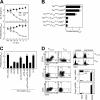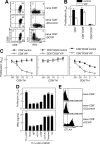Vasoactive intestinal peptide generates human tolerogenic dendritic cells that induce CD4 and CD8 regulatory T cells
- PMID: 16397128
- PMCID: PMC1895772
- DOI: 10.1182/blood-2005-11-4497
Vasoactive intestinal peptide generates human tolerogenic dendritic cells that induce CD4 and CD8 regulatory T cells
Abstract
Induction of antigen-specific tolerance is critical for autoimmunity prevention and immune tolerance maintenance. In addition to their classical role as sentinels of the immune response, dendritic cells (DCs) play important roles in maintaining peripheral tolerance through the induction/activation of regulatory T (T(reg)) cells. The possibility of generating tolerogenic DCs opens new therapeutic perspectives in autoimmune/inflammatory diseases. Characterizing endogenous factors that contribute to the development of tolerogenic DCs is highly relevant. We here report that the immunosuppressive neuropeptide vasoactive intestinal peptide (VIP) induces the generation of human tolerogenic DCs with the capacity to generate CD4 and CD8 T(reg) cells from their respective naive subsets. The presence of VIP during the early stages of DC differentiation from blood monocytes generates a population of IL-10-producing DCs unable to fully mature after the effects of inflammatory stimuli. CD4 T(reg) cells generated with VIP-differentiated DCs resemble the previously described Tr1 cells in terms of phenotype and cytokine profile. CD8 T(reg) cells generated with tolerogenic VIP DCs have increased numbers of IL-10-producing CD8(+)CD28(-)-CTLA4(+) T cells. CD4 and CD8 T(reg) cells primarily suppress antigen-specific T(H)1-mediated responses. Therefore, the possibility of generating or expanding ex vivo tolerogenic DC(VIPs) opens new therapeutic perspectives for treating autoimmune diseases and graft-versus-host disease after allogeneic transplantation in humans.
Figures





Similar articles
-
Generating tolerogenic dendritic cells with neuropeptides.Hum Immunol. 2009 May;70(5):300-7. doi: 10.1016/j.humimm.2009.01.020. Hum Immunol. 2009. PMID: 19405171
-
The neuropeptide vasoactive intestinal peptide generates tolerogenic dendritic cells.J Immunol. 2005 Dec 1;175(11):7311-24. doi: 10.4049/jimmunol.175.11.7311. J Immunol. 2005. PMID: 16301637
-
Vasoactive intestinal peptide induces regulatory dendritic cells with therapeutic effects on autoimmune disorders.Proc Natl Acad Sci U S A. 2005 Sep 20;102(38):13562-7. doi: 10.1073/pnas.0504484102. Epub 2005 Sep 6. Proc Natl Acad Sci U S A. 2005. PMID: 16150720 Free PMC article.
-
Regulation of dendritic cell differentiation by vasoactive intestinal peptide: therapeutic applications on autoimmunity and transplantation.Ann N Y Acad Sci. 2006 Nov;1088:187-94. doi: 10.1196/annals.1366.004. Ann N Y Acad Sci. 2006. PMID: 17192565 Review.
-
Tolerogenic dendritic cells: cytokine modulation comes of age.Blood. 2006 Sep 1;108(5):1435-40. doi: 10.1182/blood-2006-03-006403. Epub 2006 May 9. Blood. 2006. PMID: 16684955 Review.
Cited by
-
Ocular and systemic bio-distribution of rhodamine-conjugated liposomes loaded with VIP injected into the vitreous of Lewis rats.Mol Vis. 2007 Dec 7;13:2263-74. Mol Vis. 2007. PMID: 18451986 Free PMC article.
-
Adaptive immune regulation of glial homeostasis as an immunization strategy for neurodegenerative diseases.J Neurochem. 2010 Sep 1;114(5):1261-76. doi: 10.1111/j.1471-4159.2010.06834.x. Epub 2010 May 26. J Neurochem. 2010. PMID: 20524958 Free PMC article. Review.
-
Dendritic cells: cellular mediators for immunological tolerance.Clin Dev Immunol. 2013;2013:972865. doi: 10.1155/2013/972865. Epub 2013 May 15. Clin Dev Immunol. 2013. PMID: 23762100 Free PMC article. Review.
-
Pathogenesis of achalasia cardia.World J Gastroenterol. 2012 Jun 28;18(24):3050-7. doi: 10.3748/wjg.v18.i24.3050. World J Gastroenterol. 2012. PMID: 22791940 Free PMC article. Review.
-
How tolerogenic dendritic cells induce regulatory T cells.Adv Immunol. 2010;108:111-65. doi: 10.1016/B978-0-12-380995-7.00004-5. Adv Immunol. 2010. PMID: 21056730 Free PMC article. Review.
References
-
- Banchereau J, Briere F, Caux, C, et al. Immunobiology of dendritic cells. Annu Rev Immunol. 2000; 18: 767-811. - PubMed
-
- Steinman RM, Hawiger D, Nussenzweig MC. Tolerogenic dendritic cells. Annu Rev Immunol. 2003;109: 685-711. - PubMed
-
- Rutella S, Lemoli RM. Regulatory T cells and tolerogenic dendritic cells: from basic biology to clinical applications. Immunol Lett. 2004;94: 11-26. - PubMed
Publication types
MeSH terms
Substances
Grants and funding
LinkOut - more resources
Full Text Sources
Other Literature Sources
Research Materials

